Clematis Hegley Hybrid - variety description and cultivation features
In 1956, English breeder Percy Picton introduced a new development - Clematis Hegley Hybrid (or Hegley Hybrid). The medium-sized liana belongs to the Zhakman group, appreciated for its bright, lush flowering and unpretentious cultivation. Consider the main characteristic of the variety, the rules for planting and caring for it.
- Description of the variety
- Landing rules
- Place and soil
- Seedling preparation
- Landing technique
- Care requirements
- Watering
- Top dressing
- Pruning
- Preparing for winter
- Reproduction methods
- By dividing the bush
- Stem layering
- Cuttings
- Diseases and pests
- Prophylaxis
- Application rules in landscape design
- Gardeners reviews
- Useful videos

Clematis hegley hybrid
Description of the variety
The botanical name is clematis Hagley Hybrid.
The plant has good frost resistance (zone 4-9). Therefore, it can be safely grown not only in the south, but also in regions with a harsh and continental climate.
External features:
- stems are thin, tough, dark brown or purple, 2-2.5 m long;
- emerald leaves, with a matte surface, elongated with a pointed tip;
- inflorescences can reach 17-18 cm in diameter;
- petals are light pink with a lilac tint and pearlescent tint, contain a corrugated strip in the center;
- the anthers are purple-burgundy.
Long bloom - from July to September.
Landing rules
Several factors are considered the key to successful growth, development and colorful flowering - high-quality planting material, a good place and soil for growing.
Usually clematis are planted in the spring - in mid or late April. But in some regions (Krasnodar Territory, Astrakhan Region and Kuban), autumn landing is allowed - until early October.
Regardless of the season, it is important that the soil warms up to 10-12 ° C, and the outside temperature is not lower than 15 ° C.
Place and soil
If you plant a shrub in the sun, its inflorescences and leaves will quickly burn out. When planted in the shade, flowering will be poor and foliage will turn pale. Therefore, choose a place where the sun shines in the morning and evening, and there is shade at lunchtime.
You can plant it at a distance of 50 cm from the walls of the house, outbuilding, near the arch, gazebo. It is important that there are no stagnant water and drafts on the site.
The ground must be slightly acidic, otherwise clematis will grow and bloom poorly. If necessary, add a deoxidizer - 350 g per 1 m² (calcite, dolomite flour or slaked lime).
Depending on the type of soil, the site is flavored with different components:
- sand, perlite or vermiculite is added to clay soil - 20 kg / m² in order to increase its loose structure;
- if cultivation is planned on sandy loam, sprinkle with clay - 2 buckets for the same area.
After adding all the components, the soil is dug up, leveled and watered.
Seedling preparation
You can buy seedlings in one of the gardening nurseries, where you will probably be presented with a real bush with all varietal characteristics.
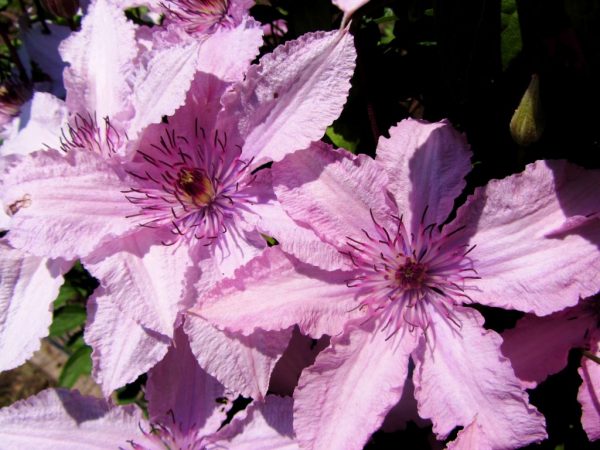
Hegley Hybrid Clematis
Choose grown bushes in which the aerial part consists of several branches with leaves and buds.Such plants have developed rhizomes, so they will safely transfer planting to the site.
Carefully inspect the crown - it should not have mechanical injuries and signs of infection with diseases, parasites. Usually, clematis are sold in an earthen coma or in a container, so their root system is protected from drying out until the moment they are planted in open ground.
Before planting, the roots are dipped in a container of cold water, then cut to 2-3 cm in length to stimulate the rapid growth of new roots.
Landing technique
Clematis are planted at a distance of 1 m. This space is enough so that in the future there is no competition for moisture and nutritional components. The pits are harvested in 2 weeks so that the substances embedded in them have time to settle. Approximate parameters - 50x60 cm.
A little drainage is poured into the bottom - pebbles, crushed stone, screenings or brick chips to improve the outflow of excess moisture. Sprinkle on top with a fertile mixture. A bucket of dug earth will require 5 kg of humus (compost), 300 g of ash, 100 g of superphosphate and 80 g of potassium sulfate.
The soil mixture is filled half the volume of the hole, then tamped. A hole is pulled out in the center, the rhizome is lowered into it, covered with soil to the top, compacted, watered (water consumption per seedling is 20-25 liters).
To prevent rapid evaporation of moisture, the trunk circle is mulched with peat or sawdust. The stems are tied to a support.
Also, to protect against overheating of the roots, undersized ornamental crops are planted around the bush - mint, marigolds, calendula, tansy. They create shade and thin out a specific scent that repels harmful insects.
When planting seedlings with lignified roots, it is necessary to deepen the root collar by 10 cm, which will further stimulate lush branching. If you are planting young plants with green shoots, this part of the bush should remain on the soil surface.
Care requirements
It is not difficult to take care of clematis, the main thing is to carry out all activities on time and correctly.
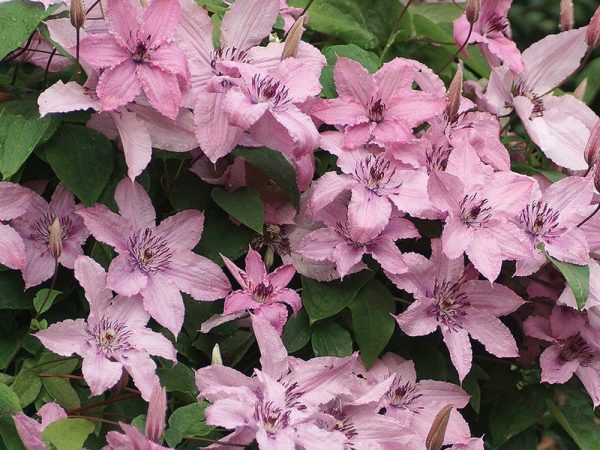
Clematis Hegley Hybrid variety description photo
In the first two weeks, the seedlings are provided with high-quality shading at lunchtime to prevent wilting and drying out.
Watering
Water is watered every day for a month to speed up the rooting process and stimulate the growth of green mass.
Further moistening is required as the soil dries to a depth of 5-6 cm. It is also worth considering the amount of precipitation in order to prevent waterlogging. With an excess of moisture, the roots begin to rot quickly.
Be sure to moisten in early spring before the leaves bloom, at the stage of bud formation, after flowering and in late autumn, when the plant will throw off all the foliage. Use warm and settled water to avoid hypothermia of the roots.
After watering, weed shoots are removed, the soil is weeded between the bushes. Then add mulch from peat, compost, straw or sawdust.
In extreme heat and drought, clematis is irrigated with water to prevent burnout and yellowing of the crown. The procedure is carried out in the evening when the sun goes down.
Top dressing
In the first three years, the seedlings have enough nutrients that were laid during planting.
After they begin to fertilize with organic and mineral preparations every year:
- At the beginning of spring (in the middle or at the end of March), the near-stem zone is watered with a nitrogen-containing solution. Use nitrophoska, nitroammophoska, urea or ammonium nitrate. Dissolve 15 g of the substance in a bucket of water. Consumption for one bush - 5 liters.
- At the stage of bud formation, they are fed with superphosphate and potassium sulfate - 1 tbsp each. l. 10 liters of water. Consumption - 5 liters of working fluid per bush.
- Fertilize with the same agent at the end of flowering.
- In the fall, after a massive fall of leaves, a bucket of compost or rotted manure is closed up in the near-trunk zone.
All root dressing is carried out together with watering in order to accelerate the absorption of nutrients and prevent root burns.
Pruning
Hegley Highbread belongs to the third pruning group, which must be done three times per season:
- in the fall, all branches are shortened, leaving no more than two nodes above the ground surface;
- in the spring, when a young growth begins to develop rapidly, they carry out a sanitary haircut - they remove frozen, shrunken, broken off branches, as well as those growing inward and at the wrong angle;
- after flowering, it is necessary to remove dry inflorescences so that they do not take away the strength from the shrub.
Pruned with a sterile and well-sharpened secateurs, after the procedure, the crown is irrigated with copper sulfate. This will help prevent infections.
Preparing for winter
In the fall, when clematis has thrown off all the foliage, on the eve of stable cold weather, the trunk circle is spud with a thick layer of peat, hay, straw or sawdust.
Shoots are removed from the support, twisted into a ring, pinned with staples, covered with fallen leaves, covered with spruce branches or burlap on top.
The insulation is removed in the spring, when the snow melts and the threat of return frosts has passed. Untie the branches, tie them to the support.
Reproduction methods
There are three options for getting new seedlings from an adult shrub, each with pros and cons.
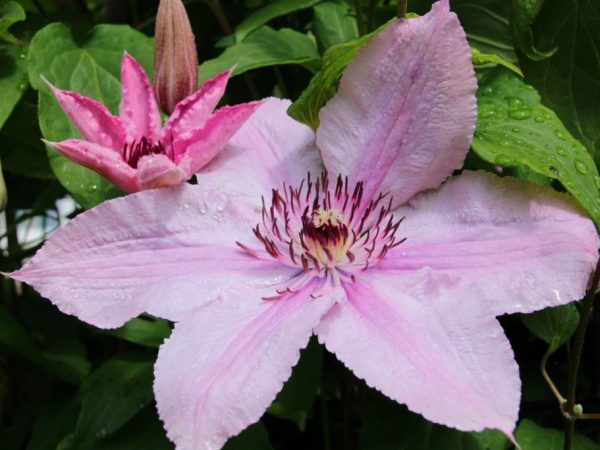
Clematis hegley hybrid description
By dividing the bush
This method is suitable for old vines that have stopped growing and bloom poorly. They need rejuvenation.
First, clematis is watered abundantly, after an hour, when the soil is soaked, dug out, dipped in a container with water. When the roots are cleared of soil, they are removed and dried.
Then, using a garden shovel or a sharp knife, the rhizome is cut into pieces. For successful rooting, each delenka must have several roots and at least one shoot with live buds.
Places of cuts are sprinkled with charcoal, planted in the same way as purchased seedlings.
Stem layering
This procedure is started in the fall, when clematis has dropped all the foliage. On it, a flexible and long branch is chosen, close to the surface of the soil. They are bent to the ground, lowered into a previously dug groove to a depth of 5-6 cm. Sprinkle with a nutritious composition of humus, peat and sand mixed in equal amounts. Sprinkle with warm water.
Before freezing, they are covered with sawdust or fallen leaves so that the layers do not freeze out over the winter.
In the spring, when the snow thaws, a twig is dug out, cut off from the mother bush, and divided into segments with roots. They are planted separately in a flower garden or garden, keeping a distance of 1 m.
Cuttings
Shoots for planting are cut in spring or summer during sanitary cutting. Take green parts with internodes, buds and leaves. At the bottom, all the leaves are cut off, dipped in Kornevin's solution for an hour, then planted in a wet mixture of peat and sand to a depth of 3-4 cm.
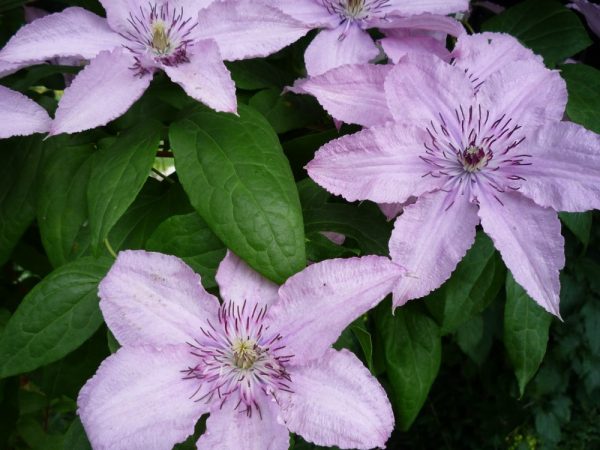
Clematis hybrid hegley hybrid
The seedlings are watered with warm water, covered with foil and placed in a warm place with diffused daylight. Further care consists in regular ventilation and moistening as the soil mixture dries out.
As soon as they release new leaves, the film is removed, they continue to grow for another 1-1.5 months, then they are planted on the site.
Diseases and pests
Clematis has good immunity against diseases, but if the rules of planting and care are violated, it can be damaged by several infections and pests.
| Type of disease | Description | Treatment |
| Powdery mildew | The causative agent is a fungus that appears in the form of a white oily coating on the stems and leaves. The affected areas darken, die off. | The crown is freed from diseased areas, then sprayed with Azocene, Skor, Hom or Topaz. |
| Rust | Brown or reddish shapeless growths on the surface of the stems, foliage are a sure sign of infection with this sore.Without proper treatment, the leaves turn yellow and crumble. | First, diseased organs are cut out, then the crown is irrigated with fungicides - Bordeaux liquid, copper sulfate or Ridomil gold. |
| Gray rot | Appears in wet and rainy weather. Signs - brown spots with a grayish bloom on the leaves, stems. The affected areas die off, the shrub stops growing, and dies over time. | It is necessary to destroy all sore spots, then irrigate the crown with Azocene solution or Bordeaux liquid. |
| Wilt (wilting) | Dangerous sore, causes rapid wilting of stems and leaves. | It is not subject to treatment, so the vine is dug up and burned. The place of growth is spilled with a strong solution of potassium permanganate or copper sulfate. |
| Aphid | It settles in colonies on the inner side of the leaves, sucks the juices out of them, which leads to curling, drying out and foliage falling off. | In isolated cases of infection, natural remedies are used - an infusion of tobacco, garlic, orange peels or onions. If this does not help, they resort to chemistry - irrigate the crown with Karbofos or Aktellik |
| Nematode | This insect parasitizes on the root system of clematis. Clogs blood vessels, thus blocking access to oxygen, moisture and nutrients. The crown begins to rapidly wither, turn yellow and dry out. | It is difficult to save a sick plant, so it is dug up, disposed of. The well is spilled with a solution of copper sulfate. |
| Slugs and snails | Leaves are eaten out at the edges, leaving holes and silvery stripes on their surface. | use chemicals - Thunderstorm, Slug-eater. To avoid re-invasion, sprinkle the tree trunk circle with wood ash or coniferous sawdust. |
Prophylaxis
To preserve the decorative effect and strong immunity of the vine, you must adhere to simple prevention rules:
- buy healthy seedlings;
- comply with the scheme and timing of their disembarkation;
- regularly remove weeds, carrion, weed the soil between the bushes;
- timely cut out non-viable parts;
- irrigate the crown, the soil under it in early spring and late autumn with fungicides;
- water, fertilize and periodically inspect for damage by insects and diseases.
Application rules in landscape design
This plant is of great value to landscape designers:
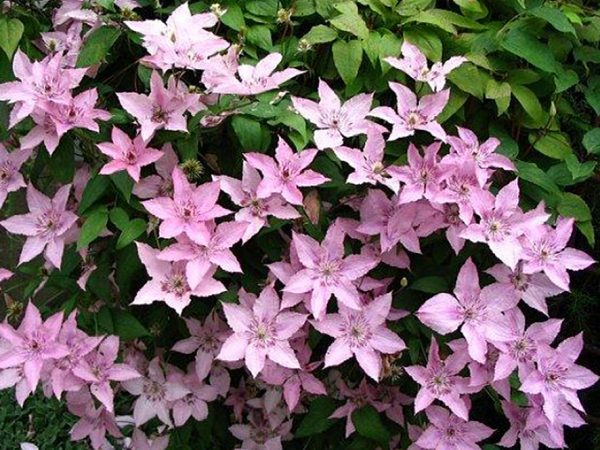
Clematis Hegley Hybrid planting and care:
- it is planted singly near arches, pergolas, bushes and trees, as well as near the walls of houses and outbuildings;
- a terrace or a gazebo braided with a liana looks beautiful and bright;
- combine with other varieties of clematis to create a multi-colored liana-like composition;
- combined with low-growing and ground cover perennials, which are planted in the near-stem zone of the bush.
Gardeners reviews
Clematis Hegley Hybrid has received many good reviews from gardeners, which made the perennial vine especially popular:
- not afraid of frost, successfully developing on any type of soil, with the introduction of the necessary components;
- it reproduces in different parts, so you can grow new bushes with all the signs of the mother plant yourself at no cost;
- tolerates a haircut well and recovers quickly after it;
- grows fully in combination with other decorative vegetation, which allows it to be used in creating unusual and original compositions.

